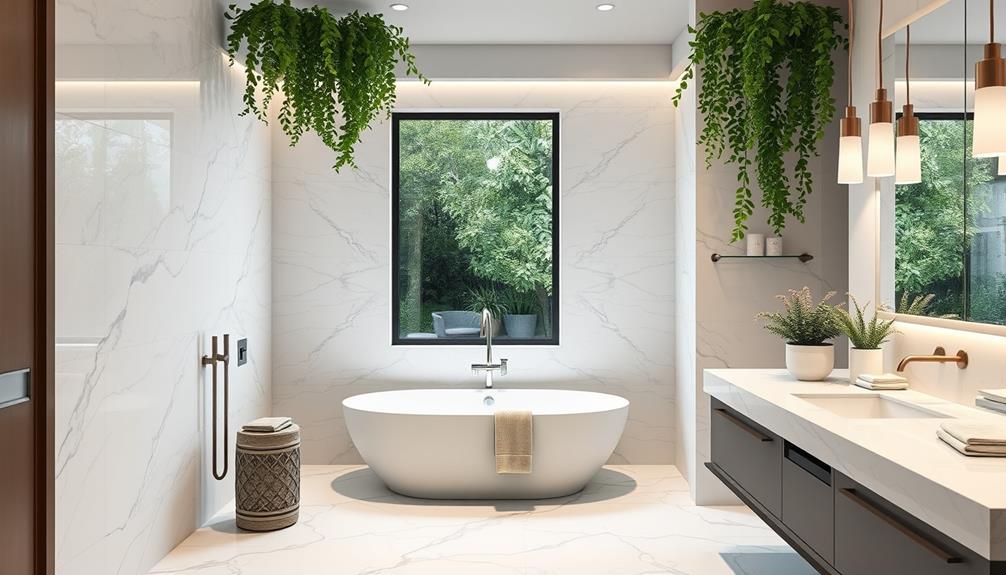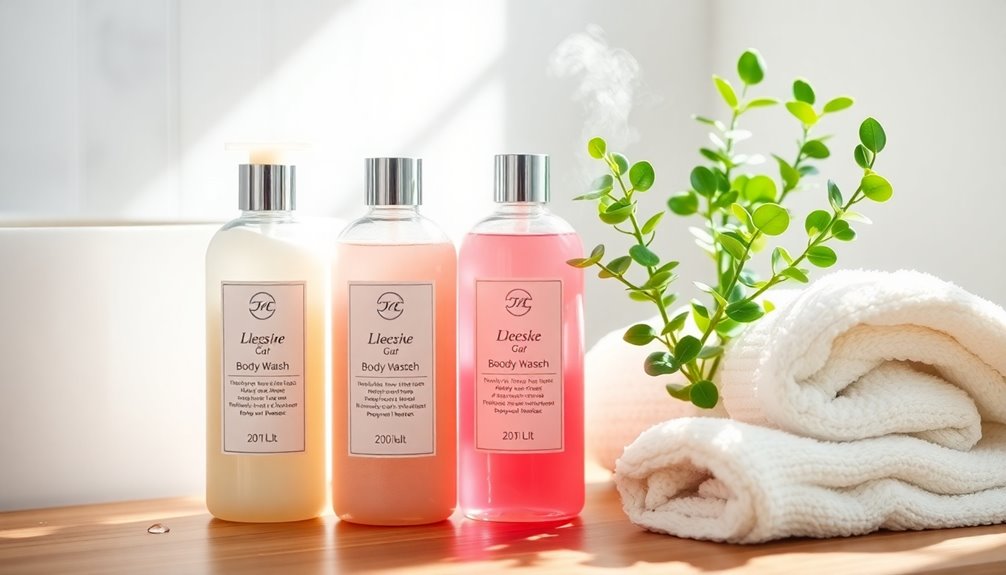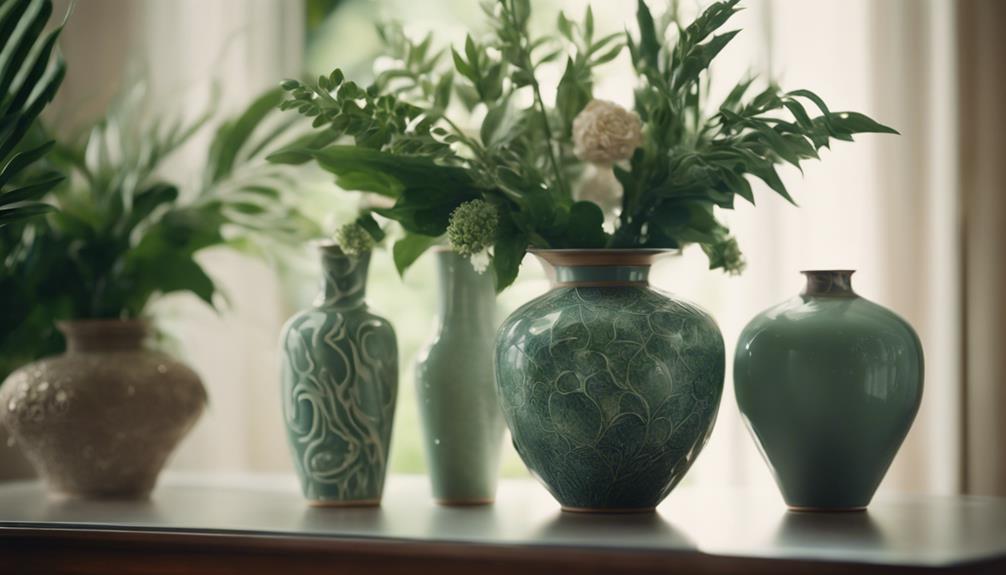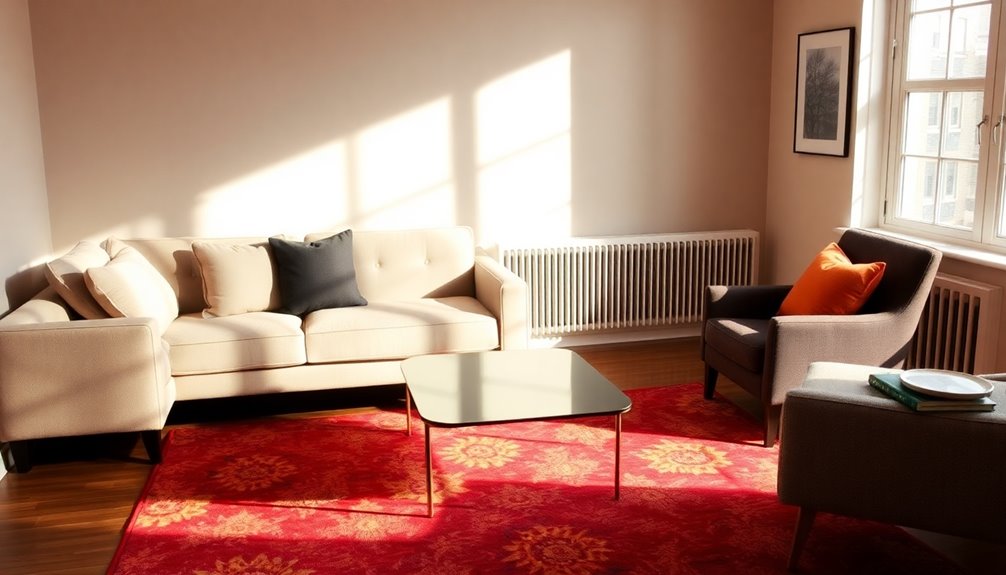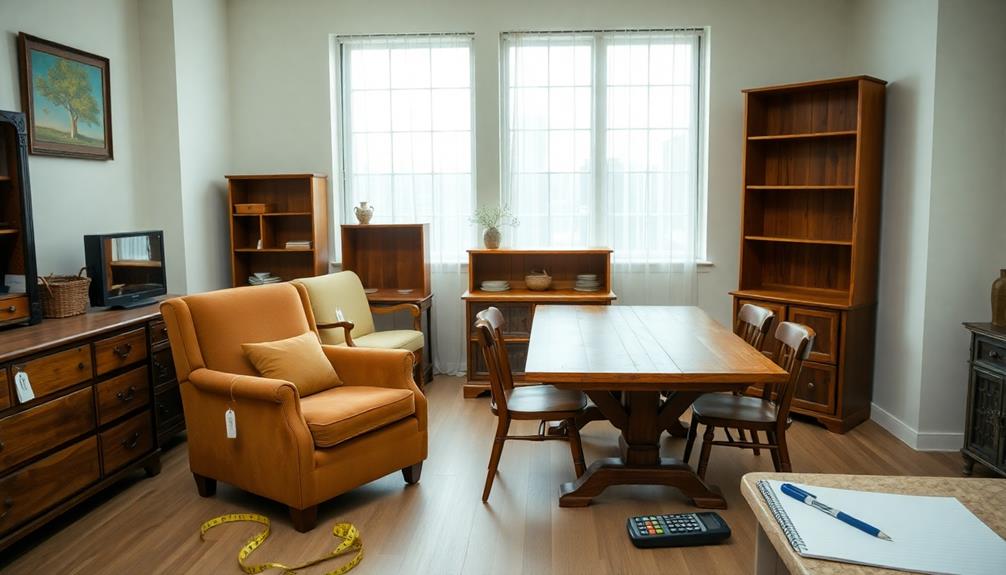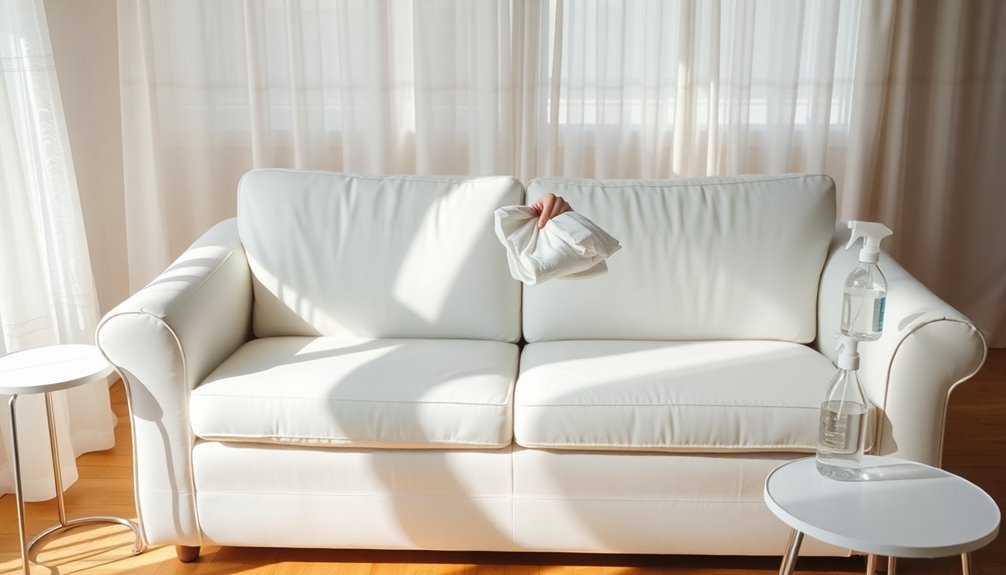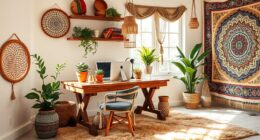To start a bathroom renovation, begin by assessing your requirements and determining the primary purpose of the space. Establish a defined budget, typically ranging from $10,000 to $30,000, and prioritize crucial features. Examine your current layout to enhance functionality and consider the placement of fixtures for convenience. Opt for waterproof and durable materials, such as porcelain tiles, and choose a calming color palette to establish a serene atmosphere. Lastly, add unique design elements and intelligent storage solutions to personalize your space. By following these steps, you will create a harmonious and elegant bathroom that suits your needs and preferences. There is still so much more to discover!
Key Takeaways
- Assess your bathroom needs by defining its purpose, establishing a budget, and analyzing the current layout for improved functionality.
- Prioritize essential features, optimize space with smart storage solutions, and ensure accessibility in the layout design.
- Select durable materials and finishes, focusing on waterproof options and coordinating fixtures for a polished look.
- Incorporate luxurious elements and a cohesive color palette to enhance aesthetics and promote relaxation within the space.
- Personalize your bathroom with unique design elements, accessories, and custom solutions that reflect your individual style and enhance comfort.
Assessing Your Bathroom Needs
When you start planning your bathroom remodel, the first step is to evaluate your bathroom needs. Begin by identifying the primary purpose of your bathroom. Is it a master bath for relaxation, a busy three-quarter bath for efficiency, or a compact powder room for guests? Understanding its function will guide your renovation decisions.
Additionally, contemplate your budget and how it aligns with your remodeling goals, as having a clear financial plan can prevent common financial terms from derailing your project.
Next, take a close look at the size and bathroom layout of your current space. Determine if you need to make changes for improved functionality and space optimization. Reflect on the needs of all users, including family and guests, ensuring accessibility and comfort for everyone.
Evaluate your existing plumbing and electrical setups, as these will influence where you can place fixtures and amenities. Are there any limitations to reflect on?
Prioritize essential features based on your lifestyle. Think about storage solutions; do you need extra cabinets or shelves? Also, contemplate your lighting needs and any spa-like elements that could enhance your experience.
Exploring Design Concepts
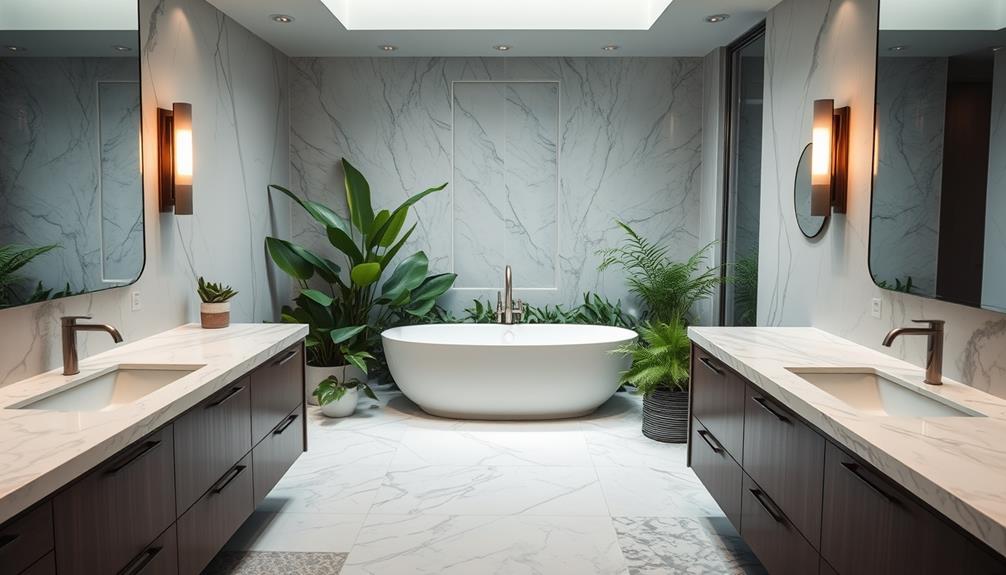
Exploring design concepts for your bathroom remodel opens up a world of possibilities to create a space that reflects your style and meets your needs. Whether you're working with a master bath or a small space like a powder room, you can achieve a stunning look with the right elements.
Consider incorporating luxurious features, such as a freestanding tub or a spacious shower enclosure, to enhance your bathroom's functionality and aesthetics. For smaller spaces, elegant fixtures and high-end finishes can elevate the design without making it feel cramped.
When it comes to color schemes, opt for soothing palettes that promote relaxation, especially if you're aiming for a spa-inspired design. Layered lighting also plays a significant role; strategically placed fixtures can create an inviting ambiance while ensuring functionality.
Here's a quick reference table to guide your design choices:
| Design Element | Functionality | Aesthetic Appeal |
|---|---|---|
| Shower Enclosure | Maximizes space in small areas | Creates a modern focal point |
| Color Scheme | Sets the mood for relaxation | Enhances overall design harmony |
| Lighting Options | Improves visibility and safety | Adds warmth and style |
With these concepts in mind, you're ready to create your dream bathroom!
Budgeting for Your Remodel
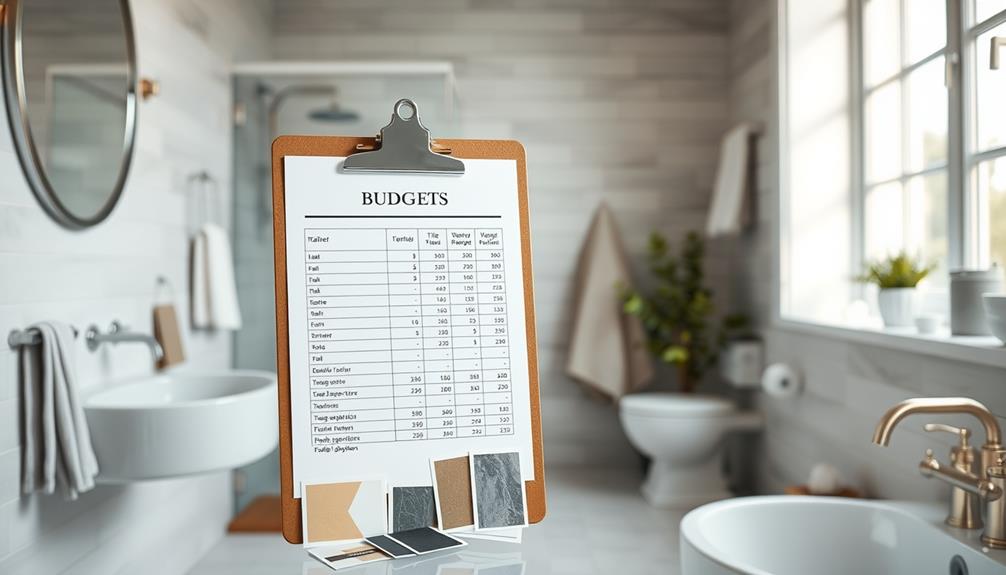
Budgeting for your bathroom remodel is essential to guarantee you stay on track financially while creating the space you desire. Typically, a mid-range bathroom remodeling budget ranges from $10,000 to $30,000, depending on size and finishes.
Start by creating an extensive budget that outlines typical renovation costs: allocate 20-30% for labor, 30-40% for materials, and reserve some funds for permits and unexpected expenses. Additionally, consider incorporating natural remedies alongside conventional ideas that can enhance your bathroom's functionality and ambiance.
Identify areas where you can splurge versus save. Prioritize important fixtures that impact functionality, like toilets and sinks, while exploring budget-friendly alternatives for decor and accessories. This strategy can help you maximize your investment without compromising on quality.
Consider financing options, as many homeowners finance 30-50% of their remodeling projects through personal loans or home equity lines of credit.
Selecting Materials and Finishes
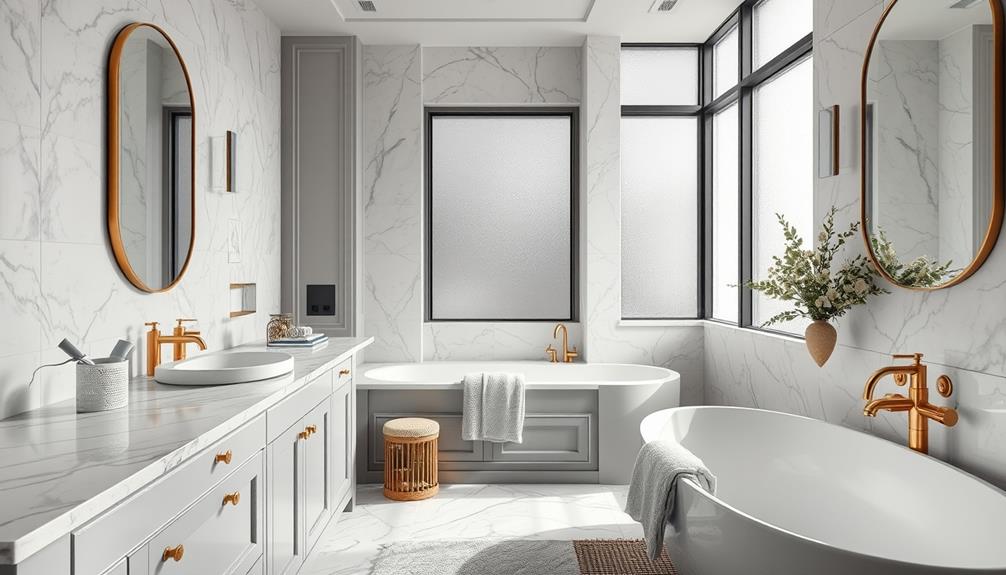
Selecting the right materials and finishes is vital for transforming your bathroom into a stylish and functional space. Start by prioritizing waterproof and durable flooring options, like porcelain tiles or vinyl. These materials guarantee longevity and resist moisture, which is essential in a bathroom environment.
For your walls, consider eye-catching wall tile options, such as glass or ceramic, that not only enhance aesthetics but also make maintenance a breeze. Additionally, choosing low-maintenance materials can ease the cleaning process, similar to how effective natural ingredients for grout cleaning can simplify upkeep.
When it comes to finishes, make sure they complement each other. Coordinating faucet and hardware finishes can create a cohesive and polished look that ties everything together. Don't shy away from adding specialty features like custom vanities or unique sink designs to give your bathroom a personal touch.
Additionally, think about eco-friendly materials and fixtures. Low-flow faucets and recycled tiles not only promote sustainability but also enhance the overall design. Incorporating these choices won't only elevate your bathroom's style but also contribute to a healthier environment.
With thoughtful selections, you can create a space that reflects your taste while being practical and sustainable.
Planning the Layout
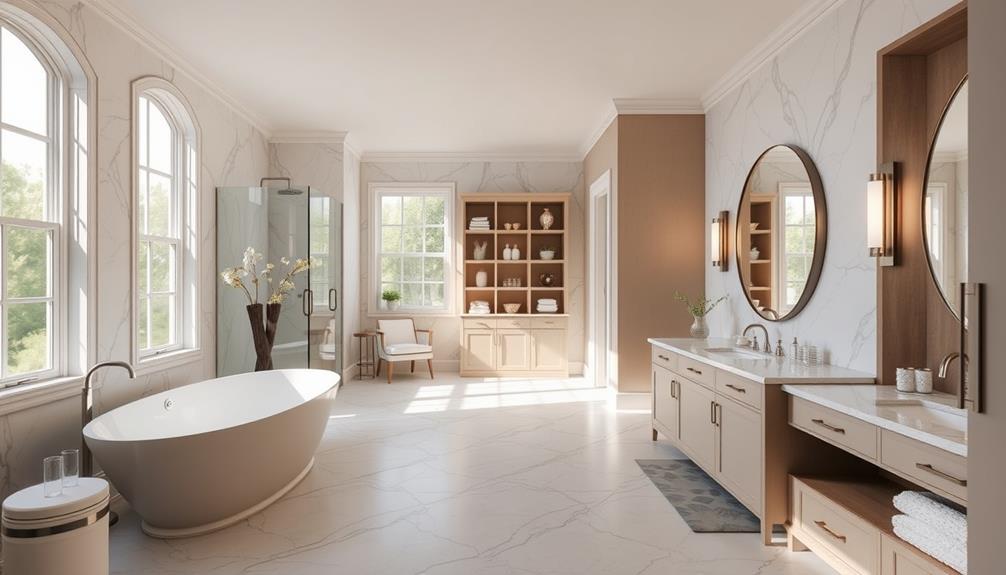
A well-planned layout is essential for maximizing both functionality and comfort in your bathroom remodel. Start by evaluating your existing bathroom layout to identify fixed elements like plumbing and electrical systems. This appraisal will help you understand what changes are feasible without driving up renovation costs.
Additionally, keeping in mind the need for financial considerations for elderly care can be beneficial if you're designing a space to accommodate aging family members.
Next, prioritize the placement of essential fixtures—sinks, toilets, and showers—to enhance accessibility and flow. Consider using design tools like RoomSketcher to visualize your new layout in both 2D and 3D, making it easier to communicate ideas with contractors.
If you're dealing with a small bathroom, think about space optimization strategies. You might merge small rooms or choose slimmer fixtures to free up usable space and create a more open feel.
Define specific areas for storage, ensuring cabinetry and shelving are strategically placed for organization and ease of use.
Remember that bathroom walls can also be used to create built-in storage, further maximizing your space.
With careful planning and thoughtful layout decisions, you'll create a bathroom that's both functional and inviting.
Installation Process Overview
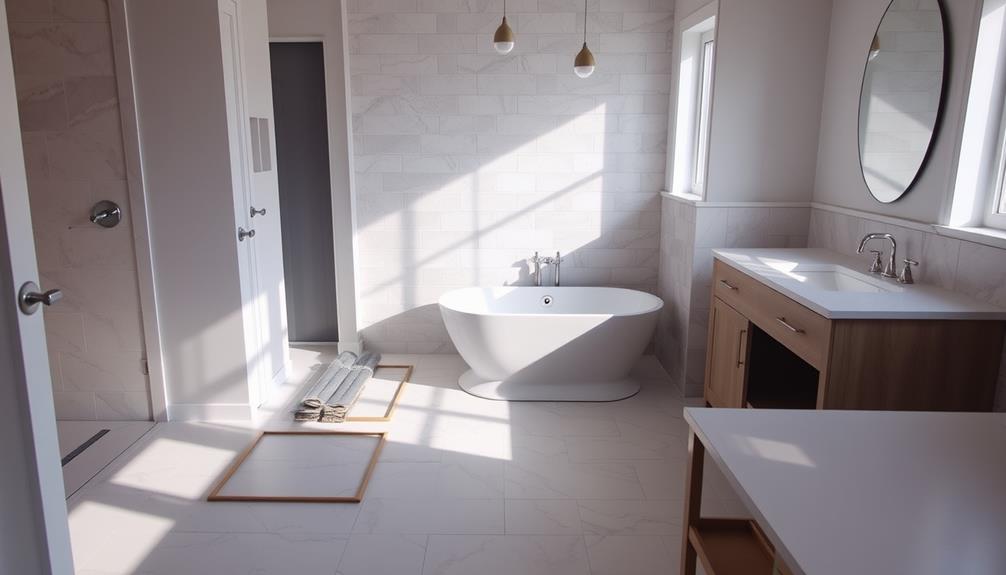
When kicking off your bathroom remodel, understanding the installation process is essential to confirm everything runs smoothly. Start by preparing the space: turn off the water and electricity, and remove existing fixtures. This preparation sets the stage for the plumbing rough-in, where you'll install new shower pans or tubs, extend water lines, and complete electrical work like GFCI outlet placement.
Additionally, verifying that your heating system, such as a heat pump, is functioning efficiently can contribute to a comfortable environment during the remodel. Energy-efficient models can reduce heating and cooling costs considerably.
Next, verify moisture resistance by installing cement board and vapor barriers in wet areas before adding drywall. Once that's in place, it's time for tile installation.
Begin with the shower walls, using laser lines and spacers to keep everything aligned and evenly spaced, then move on to the floor tiles.
Personalizing Your Space
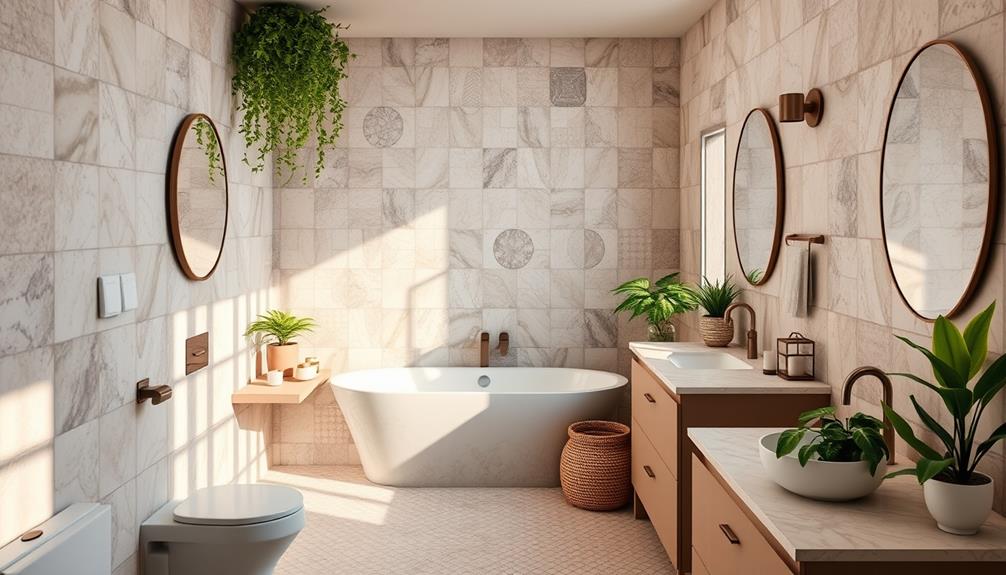
Personalizing your bathroom is all about incorporating unique design elements that reflect your style.
By choosing the right colors and materials, you can create a space that feels both functional and inviting.
Consider how a thoughtful layout can enhance your daily routine while showcasing your personality.
Utilizing mood boards can help visualize your ideas and guarantee coherence in your design choices, while blending beauty with practicality can add that unique charm to your space.
Unique Design Elements
Unique design elements can truly transform your bathroom into a reflection of your personal style. Start by incorporating unique tile designs, like unexpected black and white patterns, which add visual interest and a contemporary flair.
Consider adding personalized touches, such as vintage wallpaper or custom cabinetry, to showcase your individuality and make your bathroom stand out. To enhance the farmhouse aesthetic, think about incorporating rustic mirrors with wooden frames, reminiscent of key features of a farmhouse bathroom, which add charm and character to your space.
Next, think about a statement mirror or distinctive lighting fixtures. These can enhance the overall ambiance and serve as eye-catching focal points in your design.
Don't forget to integrate natural elements, like potted plants or wood finishes, to bring warmth and tranquility to the space, fostering a relaxing atmosphere.
Lastly, embrace technology by utilizing smart devices. Programmable lighting and heated floors not only improve functionality but also create a modern, personalized experience that elevates your everyday routine.
Color and Material Choices
Choosing the right colors and materials can make a significant difference in how your bathroom feels and functions. A cohesive color palette enhances the aesthetic appeal and creates harmony, much like how a well-prepared cup of coffee can elevate your morning routine.
Lighter shades can make your space feel larger, while natural materials like wood or stone add warmth and texture, promoting a spa-like atmosphere. Understanding the importance of various brewing methods can also inspire creative choices in your design.
When selecting materials, consider the following:
- Durable materials: Opt for ceramic tiles or quartz countertops that withstand moisture and wear.
- Natural materials: Incorporate elements like wood or stone for a relaxing touch.
- Accent colors: Use accessories like towels, rugs, and wall art to introduce bold patterns or colors.
- Fixtures: Choose faucets and cabinet hardware in finishes like brushed nickel or matte black to elevate the overall style.
- Color palette: guarantee all elements work together to create a cohesive look.
Functional Layout Considerations
An effective bathroom remodel goes beyond color and material choices; it also hinges on a functional layout that meets your specific needs.
Start by evaluating your current layout to see if significant changes are necessary. Consider plumbing locations and existing space limitations while prioritizing user needs. Define how many people will use the bathroom and what amenities are essential for you.
To create a truly innovative design, you might want to explore architectural solutions that emphasize both functionality and aesthetics.
Implement space optimization strategies to maximize your area. Wall-mounted vanities and slim sinks can help you create additional storage while keeping the space uncluttered.
Pay attention to the flow of movement within the bathroom; verify fixtures like the toilet, sink, and shower are positioned for easy access and convenience.
Creating distinct zones is key to enhancing usability. Separate areas for the shower and vanity can streamline routines, improving both comfort and functionality.
This thoughtful approach not only makes your bathroom more practical but also elevates the overall experience. By focusing on these functional layout considerations, you'll design a bathroom that truly reflects your lifestyle and preferences.
Frequently Asked Questions
Is There an App to Design a Bathroom?
RoomSketcher's like having a magic wand for designing your dream bathroom. You can easily create stunning 2D and 3D layouts, customize fixtures, and visualize everything with a few clicks. It's user-friendly and incredibly fun!
In What Order Should You Renovate a Bathroom?
To renovate a bathroom, start with planning and budgeting. Then, handle demolition and prepare the space. Follow up with plumbing and electrical work, before tiling, installing fixtures, and finally, adding personal touches and finishes.
What Is the Most Expensive Part of a Bathroom Remodel?
When you plunge into a bathroom remodel, labor costs often loom like a shadow, consuming 20-35% of your budget. High-quality fixtures and intricate plumbing changes can also swell expenses, quickly turning dreams into financial burdens.
How to Remodel a Bathroom Step by Step?
To remodel a bathroom step by step, assess your layout, set a budget, prepare for demolition, handle plumbing and electrical work, then finalize with tiling and painting. Always inspect everything to guarantee it meets codes. Additionally, when choosing materials for your bathroom remodel, opt for durable and moisture-resistant options to ensure longevity and easy maintenance. Another important aspect to consider is the overall aesthetic and functionality of the space. To achieve a cohesive and visually appealing design, consider incorporating complementary fixtures and hardware. These bathroom remodel tips can help you create a beautiful and functional space that adds value to your home.
Conclusion
In wrapping up your bathroom remodel journey, remember that this isn't just about tiles and fixtures; it's about crafting a serene sanctuary tailored to your lifestyle. Embrace the process, let your creativity flow, and don't shy away from making it uniquely yours. With careful planning and thoughtful choices, you'll be transforming your space into a delightful retreat that's both functional and inviting. Enjoy every step of this exciting adventure, and soon, you'll be soaking in your beautiful new oasis!
